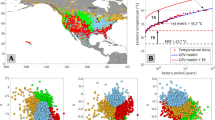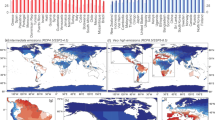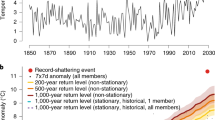Abstract
Changes in the intensity or frequency of extreme climate events can profoundly increase the disruption caused by climate change1,2,3,4. The more extreme these events, the greater the potential to push ecosystems and communities beyond their ability to cope3,5. The rate at which existing high temperature records have been broken has increased in response to rising global greenhouse gas emissions (GGHGEs)2,6,7,8, and the rate at which historical records are surpassed is projected to increase further over the coming century1,2,9,10. Here we examine future events that will be so extreme that they will not have been experienced previously. Record setting in 22 climate models11 indicates that, by the end of the twenty-first century, under business-as-usual increases in GGHGEs (representative concentration pathway (RCP) 8.5 (ref. 12)), high monthly mean temperature records will be set in approximately 58% of the world every year, and in 67% of least developed countries and 68% of small island developing states. These figures all drop to 14% under a scenario with much lower GHG concentrations (RCP2.6 (ref. 12)). In any given year, the likelihood of ‘smashing’ at least one monthly record by more than 1.0 °C is much less likely under RCP2.6 than it is under RCP8.5 (1.1 versus 8.9%).
This is a preview of subscription content, access via your institution
Access options
Access Nature and 54 other Nature Portfolio journals
Get Nature+, our best-value online-access subscription
$29.99 / 30 days
cancel any time
Subscribe to this journal
Receive 12 print issues and online access
$209.00 per year
only $17.42 per issue
Buy this article
- Purchase on Springer Link
- Instant access to full article PDF
Prices may be subject to local taxes which are calculated during checkout





Similar content being viewed by others
Data availability
The model output and observational data are publicly available from https://cmip.llnl.gov/cmip5/data_portal.html and https://crudata.uea.ac.uk/cru/data/temperature/.
Code availability
Code is available upon request from S.P.
References
IPCC: Summary for Policy Makers. In Managing the Risks of Extreme Events and Disasters to Advance Climate Change Adaptation (eds Field, C et al.) 3–21 (Cambridge Univ. Press, 2012).
Coumou, D. & Robinson, A. Historic and future increase in the global land area affected by monthly heat extremes. Environ. Res. Lett. 8, 041001 (2013).
Climate Change 2014: Synthesis Report Report (eds Core Writing Team, Pachauri, R. K. & Meyer, L. A.) (IPCC, 2014).
Battisti, D. S. & Naylor, R. L. Historical warnings of future food insecurity with uprecedented seasonal heat. Science 323, 403–406 (2009).
Harris, R. M. B. et al. Biological responses to the press and pulse of climate trends and extreme events. Nat. Clim. Change 8, 579–587 (2018).
Diffenbaugh, N. S. et al. Quantifying the influence of global warming on unprecedented extreme climate events. Proc. Natl Acad. Sci. USA 114, 4881–4886 (2017).
Lewis, S. C. & King, A. D. Dramatically increased rate of observed hot record breaking in recent Australian temperatures. Geophys. Res. Lett. 42, 7776–7784 (2015).
Rahmstorf, S. & Coumou, D. Increase of extreme events in a warming world. Proc. Natl Acad. Sci. USA 108, 17905–17909 (2011).
Lewis, S. C., King, A. D. & Mitchell, D. M. Australia’s unprecedented future temperature extremes under Paris limits to warming. Geophys. Res. Lett. 44, 9947–9956 (2017).
Lehner, F., Deser, C. & Sanderson, B. M. Future risk of record-breaking summer temperatures and its mitigation. Clim. Change 146, 363–375 (2018).
Taylor, K. E., Stouffer, R. J. & Meehl, G. A. A summary of the CMIP5 experimental design. Bull Am. Meteorol. Soc. 4, 1–33 (2007).
IPCC Climate Change 2013: The Physical Science Basis (eds Stocker, T. F. et al.) (Cambridge Univ. Press, 2013).
Fischer, E. M. & Knutti, R. Anthropogenic contribution to global occurrence of heavy-precipitation and high-temperature extremes. Nat. Clim. Change 5, 560–564 (2015).
Newman, W. I., Malamud, B. D. & Turcotte, D. L. Statistical properties of record-breaking temperatures. Phys. Rev. E 82, 1–10 (2010).
King, A. D. Attributing changing rates of temperature record breaking to anthropogenic influences. Earths Future 5, 1156–1168 (2017).
Lehner, F. & Stocker, T. F. From local perception to global perspective. Nat. Clim. Change 5, 2–6 (2015).
Tebaldi, C. & Wehner, M. F. Benefits of mitigation for future heat extremes under RCP4.5 compared to RCP8. Clim. Change 5, 349–361 (2018).
Power, S. Expulsion from history. Nature 511, 38–39 (2014).
Frame, D., Joshi, M., Hawkins, E., Harrington, L. J. & Roiste, M. Population-based emergence of unfamiliar climates. Nat. Clim. Change 7, 407–412 (2017).
Sanderson, B. M., Oleson, K. W., Strand, W. G., Lehner, F. & Neill, B. C. O. A new ensemble of GCM simulations to assess avoided impacts in a climate mitigation scenario. Clim. Change 146, 303–318 (2018).
Bador, B. M. et al. Future summer mega-heatwave and record-breaking temperatures in a warmer France climate. Environ. Res. Lett. 12, 074025 (2017).
Metropolis, N. & Ulan, S. The Monte Carlo method. Am. Stat. Assoc. 44, 335–341 (1949).
Comte de Buffon, G. Essai d’arithmetique morale. Suppl. à l’Histoire Nat . 4, 365–366 (1777).
Chavaillaz, Y., Joussaume, S., Dehecq, A., Braconnot, P. & Vautard, R. Investigating the pace of temperature change and its implications over the twenty-first century. Clim. Change 137, 187–200 (2016).
Australian Bureau of Meteorology and Commonwealth Scientific and Industrial Research Organisation. Climate Change in the Pacific: Scientific Assessment and New Research Vol. 1: Regional Overview 1 (CSIRO, 2011).
Harrington, L. J. et al. Seasonal cycles enhance disparities between low- and high-income countries in exposure to monthly temperature emergence with future warming different types of events warming. Environ. Res. Lett. 12, 11 (2017).
Mahlstein, I., Knutti, R., Solomon, S. & Portmann, R. W. Early onset of significant local warming in low latitude countries. Environ. Res. Lett. 6, 034009 (2011).
King, A. D. & Harrington, L. J. The inequality of climate change from 1.5 to 2°C of global warming. Geophys. Res. Lett. 45, 5030–5033 (2018).
L east Developed Countries Under the UNFCCC (UNFCCC, 2009).
Climate Change: Small Island Developing States (UNFCCC 32, 2005).
Power, S. B., Delage, F., Colman, R. & Moise, A. Consensus on twenty-first-century rainfall projections in climate models more widespread than previously thought. J. Clim. 25, 3792–3809 (2012).
Acknowledgements
This research was partially inspired by a presentation given by M. Crosweller, the former Director-General of Emergency Management Australia, in which he highlighted major challenges faced by firefighting agencies arising from the occurrence of unprecedented and extreme bushfires in Australia. We acknowledge the World Climate Research Programme’s Working Group on Coupled Modelling, which is responsible for the Coupled Model Intercomparison Project (CMIP), and we thank the climate modelling groups for producing and making available their model output. For CMIP, the US Department of Energy’s Program for Climate Model Diagnosis and Intercomparison provides coordinating support and led development of software infrastructure in partnership with the Global Organization for Earth System Science Portals. This research was undertaken with the support of the Australian National Environmental Science Programme’s Earth Systems and Climate Change Science Hub, and with the assistance of resources from the Australian National Computational Infrastructure. We also wish to thank I. Grant for constructive comments on previous drafts.
Author information
Authors and Affiliations
Contributions
S.P devised the hypotheses. S.P. and F.D. designed the methods used. F.D. implemented the complex code required for all of the climate model analysis. S.P. and F.D. designed and implemented the Monte Carlo analyses. S.P. wrote the paper with critical input from F.D. F.D. produced nearly all the figures.
Corresponding authors
Ethics declarations
Competing interests
The authors declare no competing interests.
Additional information
Peer review information: Nature Climate Change thanks Alexander Robinson, Yangyang Xu and the other anonymous reviewer(s) for their contribution to the peer review of this work.
Publisher’s note: Springer Nature remains neutral with regard to jurisdictional claims in published maps and institutional affiliations.
Supplementary information
Supplementary information
Supplementary Tables 1–4 and Supplementary Figures 1–12.
Rights and permissions
About this article
Cite this article
Power, S.B., Delage, F.P.D. Setting and smashing extreme temperature records over the coming century. Nat. Clim. Chang. 9, 529–534 (2019). https://doi.org/10.1038/s41558-019-0498-5
Received:
Accepted:
Published:
Issue Date:
DOI: https://doi.org/10.1038/s41558-019-0498-5
This article is cited by
-
Heat stress in South America over the last four decades: a bioclimatic analysis
Theoretical and Applied Climatology (2024)
-
Future temperature extremes threaten land vertebrates
Nature (2023)
-
Climate processes and drivers in the Pacific and global warming: a review for informing Pacific planning agencies
Climatic Change (2023)
-
2021 North American heatwave amplified by climate change-driven nonlinear interactions
Nature Climate Change (2022)
-
Increasing probability of record-shattering climate extremes
Nature Climate Change (2021)



